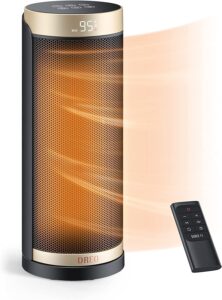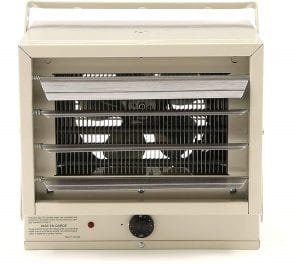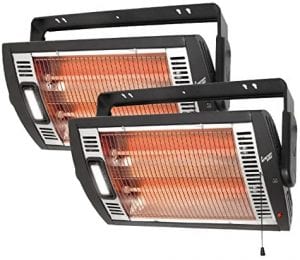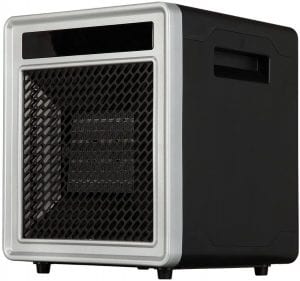The Best Garage Heater To Keep Your Home And Car Warm
We looked at the top 17 Garage Heaters and dug through the reviews from 144 of the most popular review sites including and more. The result is a ranking of the best Garage Heaters.

Our Review Process
Don't Waste Your Money is focused on helping you make the best purchasing decision. Our team of experts spends hundreds of hours analyzing, testing, and researching products so you don't have to. Learn more.
Our Picks For The Top Garage Heaters
- 1. Dr Infrared Heater Portable Electronic Thermostat Garage Heater, 1500-Watt
- 2. Dreo ETL-Certified Ultra Fast Garage Heater, 1500-Watt
- 3. ISILER Portable Ceramic Garage Heater, 1500-Watt
- 4. Mr. Heater Tabletop Propane Forced Garage Heater, 60,000-BTU
- 5. HeTR Corded Electric Convection Garage Heater, 1500-Watt
- 6. Dr. Infrared Heater DR-988 Manual Garage Heater, 5600-Watt
- 7. NewAir G73 Ultra Fast Electric Garage Heater, 17000-BTU
- 8. Dyna-Glo Liquid Propane Forced Air Garage Heater, 60000-BTU
- 9. Mr. Heater Portable Propane Radiant Heater
- 10. multifun Portable Ceramic Electric Garage Heater, 1500-Watt
- 11. AgiiMan Compact Living Room & Garage Heater, 1500-Watt
- 12. Fahrenheat FUH54 Continuous Garage/Utility Heater, 5000-Watt
- 13. Dr. Infrared Heater Wall Mounted Garage Heater, 6000-Watt
- 14. Dimplex DGWH4031G Adjustable Bracket Garage Heater, 4000-Watt
- 15. Comfort Zone Ceiling Mount Quartz Heater
- 16. King Electric KB2410-1-B2-ECO 240 Floor Office & Garage Heater, 10000-Watt
- 17. Homegear Electric Portable Space Heater
With features such as a remote control, programmable timer and dual heat options, keeping warm using this garage heater is a snap. With a cutting edge seven-inch blower, the air is heated quickly even on low speed. You'll appreciate the ultra-quiet blower, as well.
Safe and Energy EfficientThis energy-saving garage heater can heat a large room with ease.
You can't go wrong with this garage heater, which comes with a handy remote control. It heats quickly and oscillates to evenly disperse the warm air around your room. The heater runs quietly and covers an area of up to 200 square feet.
Heats in 2 SecondsThis garage heater is flame retardant and outfitted with overheat and tip-over protections.
It takes just 2 seconds for this powerful garage heater to warm up. Although the heater is tiny and portable, it can handle a room as big as 108 square feet. It features an ergonomic handle for easy carrying, a self-regulating element and automatic overheating protection.
Tip-Over ProtectionYou can adjust the thermostat on this garage heater from 41 degrees Fahrenheit to 95 degrees Fahrenheit.
Designed for jobsites, this liquid propane heater can keep large areas comfortable. The forced air heater is equipped with the Quiet Burner Technology, making it up to 50% quieter than standard propane heaters. It is capable of heating up to 1,500 square feet for up to 14 hours using a 20-pound tank on the lowest setting.
Heat Spacious Areas ContinuouslyMaintain comfortable warmth in up to 1,500 square feet with this portable garage heater.
Buying Guide
You don’t want to be working in a freezing cold garage this winter. Whether your time in there is limited or extended, you won’t regret investing in a garage heater. With a flip of the switch, your garage will be toasty warm, and your motivation will skyrocket. But there are several things to consider before purchasing a garage heater.
First, you need to look at appropriately sized units for the size of your garage. For calculated perfection, the rule of thumb is 10 watts per square foot of space. If you have an average-sized, single-car garage, you will want to check out units that are below 5,000 watts or roughly 15,000 BTUs, whereas a two- or three-car garage will need a much more powerful heater with roughly 10,000 watts or 30,000 BTUs. If you want to be exact, you can find the cubic feet of your garage by multiplying the length of the garage from front to back by the width of the front of the garage by the height of your garage.
You should also consider the efficiency of your garage.
“Make sure you’re not trying to heat the rest of the world,” says Vicki Liston, our resident home improvement expert. “Are the windows and the garage door energy efficient? Is there weather stripping around all the doors and windows? You’ll want to prep the space to reduce or minimize heat loss.”
Second, there are a few types of heaters on the market. Electric garage heaters are either hardwired into your home or plugged in with a cord through an appropriate outlet. These units can be turned on easily with a flip of a switch or by adjusting a thermostat. Some electric models come with a mounting bracket and adjustable thermostat. Consumers that frequent their garage can set these units to the desired temperature and the unit will click off once the temperature is reached. Other models offer the option of portable or ceiling-mounted units that are also electric.
You can opt for a propane- or gas-powered heater as an alternative. These heaters require ventilation to the outside as well as wiring, and often require an ignition start for the unit to be turned on. “Whether the unit is freestanding and portable or mounted on a wall, their deadly carbon monoxide fumes must be directed outside via a pipe for the heater to operate safely,” says Liston.
Some propane units feature forced hot air, portability and adjustable angling for directed heating. With so many possible safety features including tip-over shutoffs, extended hoses and backpressure switches, there are plenty of options for the safety-conscience consumer.
For additional options, you can choose from forced-air heaters that blow the air directly over hot coils to warm the air or infrared heaters that convert energy to heat when absorbed by surrounding objects. If a set-it-and-forget-it unit is what you want, look for a hardwired, infrared, commercial unit with an adjustable thermostat. These heaters have different adjustments for optimum airflow and heat control.
Third, you’ll want to know the cost of each unit and any installation fees associated with the unit to make sure it is within your budget. The installation fees vary greatly between the different options, so be sure to talk with a home improvement specialist when determining costs. Prices on the actual units will vary throughout the year, so planning ahead might be a good idea when making this purchase. You’ll also want to check on the warranties, should anything go wrong.
Our Expert Consultant

Home Improvement Expert
Vicki Liston writes, produces, and narrates “On The Fly…DIY,” an award-winning home improvement and DIY show of unique project tutorials for the casual DIY’er.
Home improvement and all things DIY have been Liston’s passion since she bought her first house in 2007 and she started making video blogs in 2014. She’s performed hundreds of DIY projects, from small ones to major, wall-smashing renovations and can teach you how to make a trendy DIY barn door for cheap. The proceeds earned from “On The Fly…DIY” are donated to no-kill animal shelters and rescue organizations.
Why we recommend these garage heaters?
Products Considered
Products Analyzed
Expert Reviews Included
User Opinions Analyzed
Our experts reviewed the top 17 Garage Heaters and also dug through the reviews from 144 of the most popular review sites including and more. The result is a ranking of the best of the best Garage Heaters.
DWYM is your trusted roduct review source. Our team reviews thousands of product reviews from the trusted top experts and combines them into one easy-to-understand score. Learn more.
The Best Bang For Your Buck
ISILER Portable Ceramic Garage Heater, 1500-Watt
Key Takeawy
It takes just 2 seconds for this powerful garage heater to warm up. Although the heater is tiny and portable, it can handle a room as big as 108 square feet. It features an ergonomic handle for easy carrying, a self-regulating element and automatic overheating protection.
What other experts liked
What other experts didn't like
What to Look For
- Something to think about when purchasing a garage heater is the way it operates within the space. If you are a painter, or most of your projects include sanding, you really don’t want to install a forced-air heater. They stir up dust and dirt to a small degree and can make those types of projects difficult.
- For quiet heating options, infrared is your best choice. Infrared heating has become quite popular over recent years because it is not so harsh on our bodies. However, you’ll want to think long and hard about where you install it since it takes a little bit longer to heat up the space.
- Remember that if you choose a propane-powered unit, you will need to pay for outside venting when you have the unit installed.
- For upfront costs, the forced air garage heaters will be less costly versus the infrared units.
- Before starting your research on the correct unit, it is vital to know the insulation of your garage walls as well. The thickness of the walls also plays a large part in how much power you’ll need in a heater for that space. For example, if you have a single-car garage but it is not insulated and has thin walls, you may want to consider a heater with a more powerful output than what is recommended for the square footage.
- Most portable garage heaters require a 240-Volt outlet and you need to ensure the breaker can accommodate the amps (typically around 20 amps) so you don’t trip the breaker.
- No matter what you are purchasing, you should always check the warranty of the unit.
- Always have a licensed, insured professional install the unit so you are sure of the highest safety standards.
- To give your garage heater a boost, consider getting weather stripping for windows and doors. It is inexpensive and makes a significant difference in conserving energy.
- If you use a portable space heater, try to find one with a thermostat so you have the safety feature of automatic turnoff as well as the energy-saving feature it provides.
- Routinely clean off any dust or dirt that may have settled on your garage heaters. If you have a gas garage heater, it’s important to have it serviced once a year before the winter season.
- Some garage heaters are sold separately from their thermometers and cords so be sure to read what is included in your purchase.
More to Explore
- The Roman Empire thrived for so long because it was a civilization of extreme ingenuity. Case in point: they were the first to use a “central heating” system. They placed pipes in their walls and in their floors that released forced hot air from furnaces. This was called the “hypocaust” system by the Romans.
- Natural gas was used by Chinese who trapped the gas with bamboo and circulated it through bamboo pipes in roughly 500 B.C.
- Philadelphia Gas Works was the first company in the country to offer natural gas. It opened in 1836 and has the record for oldest gas company in the United States.
- Natural gas, in its natural state, is scentless. The energy companies decided to add an odor, so users can be aware of any leaks.
- In the Northeast, electricity and natural gas account for the majority of the home heating sources while wood, propane and kerosene are roughly 15 percent.
- 7.2 trillion degrees Fahrenheit is the hottest ever manmade temperature. It was created in Brookhaven Natural Laboratory in New York.




























